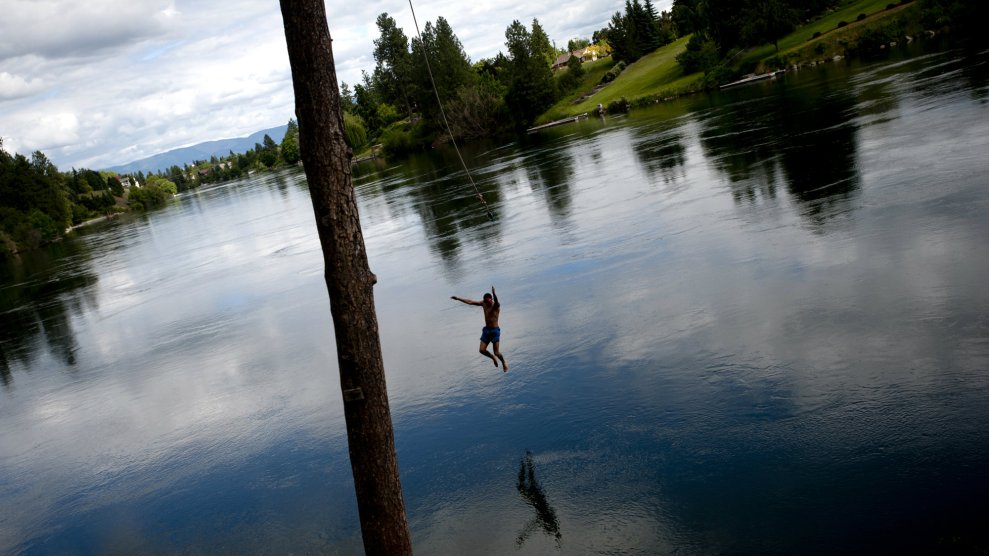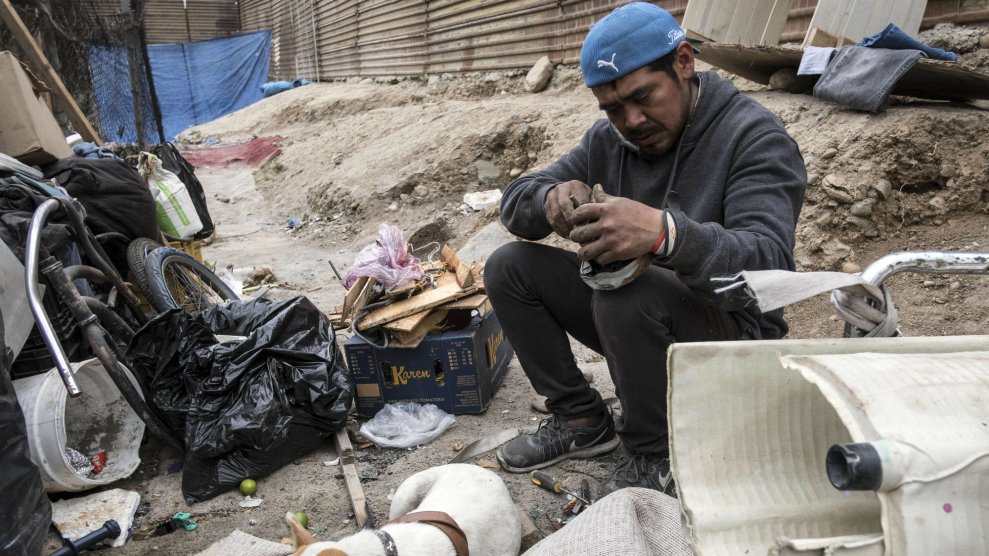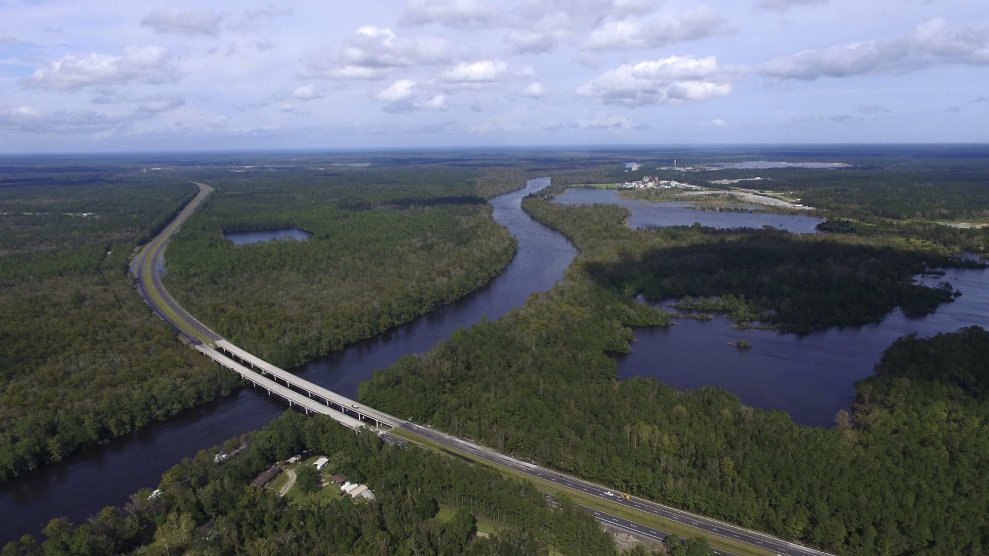
Tyler Tjomsland/Spokesman Review/Associated Press
This story was originally published by High Country News. It appears here as part of the Climate Desk collaboration.
East of Spokane, Washington, the ghost of decades-old industrial pollution still haunts the groundwater. Laden with chemicals that can cause cancer and developmental disabilities, the subsurface water flows into the Spokane River before it winds through the city and then across the Spokane Indian Reservation. Along the way, toxics pile up, contaminating fish in the river.
The Kaiser Trentwood aluminum rolling factory, a sprawling industrial complex near the riverside, now dotted with decaying concrete buildings, was once the source of much of this pollution. The still-operating factory, which manufactured metal for bombs and airplanes during World War II, no longer uses the toxic polychlorinated biphenyls (PCBs) that make up the nastiest part of the pollution. But its groundwater, which is filled with PCBs from decades of production, makes the site a major source of contamination in the Spokane River.
Today, the company is working to clean up the aquifer it once polluted. Water is drawn up from below and into a filtration system that pumps it through tanks filled with ground-up walnut shells, which capture the PCBs in their absorbent pores. The PCBs are then washed from the walnut shells and stored in tanks.
The cleanup at Kaiser Trentwood is part of a widespread effort in the watershed to exorcise the PCB demons of the past. The area has some of the nation’s most stringent PCB pollution regulations, so wastewater dischargers and environmental agencies are working to identify the sources of PCB pollution and reduce the toxic chemicals in the river. Many American cities are struggling with similar, seemingly intractable problems. Now Spokane has emerged as a leader, testing both the potential for innovation and the limits on cleaning up decades of toxic waste.
Originally developed in the late 1920s and produced exclusively by Monsanto in the United States, PCBs were a wonder chemical for industrial technology, with a high boiling point and electric insulating properties. But they also had devastating impacts on human and ecosystem health. For years, Monsanto suppressed internal findings about their toxicity. When the truth was revealed in the 1970s, the federal government outlawed the production of PCBs. Spokane, Portland, and San Diego, among other cities, are mired in lawsuits over the corporate cover-up, hoping to recoup some of the costs of the cleanup; in most places, those costs and the necessary investments in infrastructure have fallen on local tax- and ratepayers.
Like many pollutants that affect animal and human health, PCBs build up in the food chain, accumulating in small amounts in microorganisms, and then in increasing amounts in fish and the animals, like orcas and humans, that eat them. The US Environmental Protection Agency lists PCBs as probable carcinogens that also impact hormone regulation and childhood development. Pregnant women and young children are most at risk from the chemicals, which cause birth defects and developmental disabilities in populations where contaminated fish are eaten regularly.
In response, the Washington Department of Health now recommends that residents consume no more than one fish in any given month from many sections of the Spokane River, and none at all in other stretches. That is a far cry from the traditional diet of the Spokane Tribe, whose members once ate up to two pounds a day. In 2015, the tribal nation and environmental organizations won a court order to set more stringent numeric limits on PCB pollution, hoping to clean the river enough to sustain their traditional diet.
In 2016, the EPA limited the amount of PCBs allowed in Washington waterways to seven parts per quadrillion (ppq), or the equivalent of seven regular postage stamps on a letter the size of California and Oregon combined. That’s far stricter than the PCB levels allowed in drinking water by the EPA, which is 500 parts per trillion. Spokane is the first place in the state to navigate the permitting process under the tighter restrictions.
Under the Trump administration, however, the EPA is in the process of revisiting the pollution standards, despite opposition from the Washington Department of Ecology. The state environmental agency, which had originally proposed a limit of 170 parts per quadrillion, has said that changes to the rules would undermine the ongoing permitting process, which already includes exemptions that give polluters more time to reach the standards. Business interests along the Spokane River, including the Washington Farm Bureau and Northwest Pulp and Paper Association, petitioned the EPA to relax the standard.
For now, the city of Spokane and other dischargers are moving ahead on cleanup by building new wastewater infrastructure and treatment technology and evaluating sources and potential solutions to PCB pollution in the river. The city alone is spending $340 million on upgrades to stormwater and sewer treatment systems designed to keep more PCBs and other toxins out of the river. But even those major investments aren’t likely to be enough. Dischargers say the long history of PCB use in the region and the more lax standards for PCBs in manufactured products make it unrealistic to meet the new pollution standards. “It’s going to take a long time to get out, but people are looking for a short-term fix,” said Rob Lindsay, the water programs manager for Spokane County.
The efforts at the Kaiser Trentwood aluminum plant also show the gap between treatment technologies and pollution levels. Since October 2015, more than 11 million gallons of groundwater have passed through the facility’s walnut shell filtration system. When the system runs efficiently, engineers believe it can remove about three-quarters of the PCBs from the water. But after four years, the cleanup project has removed less than half an ounce of PCBs, a far cry from the almost 11 pounds the company discharged into the river in 2002.
Cleaning up PCBs in the Spokane River isn’t simply a matter of cleaning up a toxic past. PCBs are still inadvertently produced, and cleaning them up forces regulators and polluters to grapple with knotty environmental paradoxes.
Take, for example, Inland Empire Paper, a local papermaking company on the banks of the Spokane River. It’s one of five facilities in the United States that make print paper. Great billows of steam vent from the factory as paper-rolling presses turn bales of recycled paper and piles of wood chips into finished products. Despite the benefits of recycling, both for the quality of the fiber and environment, the company has had to cut the percentage of recycled paper in its products by two-thirds, and may have to stop recycling entirely.
That’s because certain dyes and inks, like the classic yellow of a Cheerios cereal box, still contain PCBs, which can be inadvertently created in chemical processes, such as colored dye manufacturing, that involve high heat and chlorine. And if Inland Empire uses paper with those dyes on it, it’s responsible for the PCB waste from them. To the frustration of wastewater dischargers and clean water advocates, EPA regulations allow those contaminants up to 50 parts per million in finished products—more than 1 billion times the amount allowed in wastewater discharges. “As long as this inadvertent PCB allowance exists, I find it very doubtful that we’ll be able to meet a standard like seven parts per quadrillion,” said Doug Krapas, the environmental manager for Inland Empire Paper.
And while Inland Empire’s decision to cut back on recycled material will lower PCB levels in the river, it only means those toxic chemicals will become someone else’s problem. “Those PCBs are going to continue to persist,” Krapas said. “They will go into landfills, they will get into the environment through airway pathways, through waste energy plants, or back to China.”
This disconnect has pushed Krapas, along with local conservation groups and Northwest tribes, to take Spokane’s PCB fight beyond the county line. They’ve sent petitions to federal regulators spelling out the problem: As long as we continue to allow PCBs to be produced in some parts of the system at such high levels, we won’t be able to get ahead of the pollution curve. They are asking the EPA to amend the Toxic Substances Control Act to lower the acceptable amount of PCBs in manufactured products. That would have international consequences, as many PCBs come from products manufactured in India and other parts of Asia.
Krapas said some companies, like Apple and Hewlett Packard, have adopted standards that require far lower PCB levels in the products they purchase and produce, and that inadvertent production of PCBs is largely avoidable. But the lack of oversight and lax rules on PCBs in manufactured products leaves facilities like Inland Empire Paper frustrated, trying to undo pollution they didn’t create and lack the technology to entirely eliminate.
Meanwhile, Spokane’s next generation is looking for innovative ways to tackle existing PCB contamination. Just half a mile from the Spokane River, the Institute of Science and Technology at North Central High School looks more like a college research center than a public high school science classroom. Tall windows gaze out over sports fields as lab partners Nick Heimbinger and Rachel Harwood pore over the latest data from the lab’s gas chromatograph, which shows how soil microbes are breaking down petrochemicals from the city’s stormwater drains.
Bioremediation, the practice of using plants, fungi, and microbes to break down pollutants, is an important part of many environmental cleanup efforts. Their experiment is part of a project, funded by the toxics task force and run by the Lands Council, that looks at using natural systems to break down PCBs. It was started after an earlier study showed some potential to use bioremediation to break down PCBs.
Unlike the previous study, which used a specific fungus, the students and their advisers are trying to supercharge a wide array of native microbes with nitrogen to get them to chew up the toxic PCBs. That will make their fix specific to Spokane. “The most successful bioremediation occurs when you are utilizing the indigenous (microbial) populations that are already suited to the land,” Heimbinger said.
PCBs are some of the toughest chemicals to destroy, as soil organisms often bypass them for marginally more appealing toxic nibbles. Biology teacher Dan Shay compares it to trapping a group of students in a buffet restaurant for a year. At first, they would eat the tasty stuff like desserts, then the less desirable food like pasta, and by the end, “they’d be stuck eating stuff like lima beans and shoe leather,” Shay said. PCBs are the shoe leather in this scenario, he explained: one of the hardest chemicals for microorganisms to digest and therefore, the last course in a bioremediation meal.
So, rather than focusing their studies directly on PCB levels in the city’s waste, the students are working to clear out the rest of the toxic buffet first. That means monitoring how quickly things like motor oil and diesel fuel disappear from the soil. If those petrochemicals are being digested, “then we know bioremediation is occurring,” Heimbinger explained. And once those other pollutants are removed, the microorganisms will be left to chew on the PCBs.
If the students can encourage the microbes to chomp on PCBs more quickly, they could then spread the treatment to contaminated sites around Spokane.
While environmental advocates and the Spokane Tribe continue to pursue strict pollution regulations, much of the momentum on PCB cleanup has come from working together and trying to solve problems outside the courtroom. “Because we are so focused on PCBs, it generates interest locally to try innovative things like this,” said Mike Petersen, the executive director of the Lands Council, who has been facilitating the bioremediation project.
“We may not be able to solve the entire PCB crisis around the world,” said Shay. “But we’re contributing to this little piece here.”















